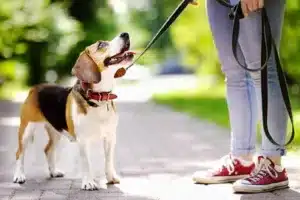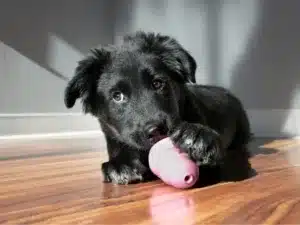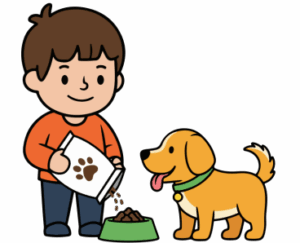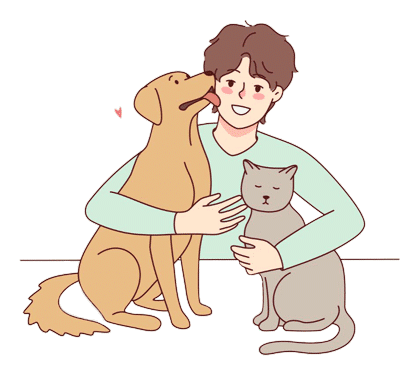Sometimes you just can’t walk your dog. Maybe, due to bad weather outside, or you have guests at home or your kids have exams coming up. Whatever the reason maybe, there are times when you can’t go out and give your dog the outdoor exercise and activity it requires. During these situations, your dog tends to get restless and destructive. Restlessness in high energy dog breeds is common. This can lead to destructive behavior like holes in your cushion, digging up your garden or chewing on expensive furniture. This is the case for fully grown dogs and puppies, if they aren’t worn out, they’ll look for a ‘job’ to do leading to destructive behavior.
 Pro animal trainer Brandon McMillan says, “Most of the breeds living in our houses today weren’t originally bred to be on a couch, in a quiet home surrounded by walls. They had jobs long before we were born and instinct is more powerful than any trainer on the planet. The first step to understanding why your dog needs to be crazy, busy, and run wild through the house is to understand the history of their breed”.
Pro animal trainer Brandon McMillan says, “Most of the breeds living in our houses today weren’t originally bred to be on a couch, in a quiet home surrounded by walls. They had jobs long before we were born and instinct is more powerful than any trainer on the planet. The first step to understanding why your dog needs to be crazy, busy, and run wild through the house is to understand the history of their breed”.
For example, Golden Retrievers were originally used to hunt birds and smaller prey. But today, they have become members of our households and families. They are expected to be indoors most times and behave in a certain way according to house rules. Many people don’t realize that Golden Retrievers still need the mental and physical fulfillment of a “job” to do. This is where long walks, hikes, swimming etc can keep them occupied. But however, there are circumstances when you cannot take them out.
Here’s a list of activities you can do indoors to keep them engaged and tire them out.
- Hire a Pet Sitter : Pet Sitters are not just for times when you are away, but they are also for times when you are busy or under the weather and your pet requires its daily routine to be taken care of. Pet sitters can take your dog out for a walk whenever required but if the situation does not permit outdoor activities, they can engage the pet with various indoor activities to keep it busy, occupied and tire it out. Due to the nature of their work, they are used to handling multiple breeds across various ages and know exactly how they can tire out the dog just by being indoors.
- Training on tricks and commands : The second way to tire out your dog indoors is through ‘Mental stimulation’ which is great to keep them entertained and occupied. Learning a new trick or command is great mental stimulation for dogs. When you teach your dog new tricks, they need to give you all of their focus. This focus, especially as you teach them to maintain it for a long stretch of time, will seriously wear them out.To get you started, here’s a list of training tasks that are great to do inside. Trainers at Pawland can also guide you through this training process and tell you the most effective way to get desired results. These exercises will help build your bond with your dog and get them to love being with you, give them some mental stimulation.
- Recall : It starts indoors. When training a reliable recall, it’s important that we don’t skip steps, and that we frequently remind our dogs how awesome it is to come when they’re called. And that’s where training indoors comes in. Inside, we can control the environment: we can minimise the distractions, and we can make the distance the dog needs to cover to get to us nice and small. Once they are trained on recall indoors, try doing this within your yard outdoors and then go on to doing it outdoors on a hike.
 Leash Walking : It’s best to begin this training inside where there is no danger if the dog wanders off. Without any leash tension to stop them from walking away, the foundation for loose leash training comes from our dogs choosing to be near us. Choice always makes for more powerful and more reliable training.
Leash Walking : It’s best to begin this training inside where there is no danger if the dog wanders off. Without any leash tension to stop them from walking away, the foundation for loose leash training comes from our dogs choosing to be near us. Choice always makes for more powerful and more reliable training.- Tricks : Some training can be just for fun! There are a bunch of impressive tricks you can teach your dog indoors. You can start super easy, with tricks like Sit Pretty, Go Behind, Speak, or Touch. Once you’ve mastered those, you can move on to advanced tricks like Footstalls, or Handstands, or even helping out around the house! The real magic of trick training is the bond it creates between you and your dog. Trick training requires dogs to problem-solve, and humans and dogs to work as a team to accomplish a goal.
- Brain Stimulating Toys : There are a ton of dog and puppy toys out there designed to entertain and tire out your dog. If you need your puppy to focus on something when he/she’s not tired, all of these toys are great options to keep her busy.
- Hyper Pet Doggie Tail Toy: This battery powered tail makes noises, jumps around, and is motion activated so that your pup can chase it around the house.
 Puppy Kong: The Kong is a tried and true form of entertainment for dogs, and it’ll be a huge lifesaver for you. Stuff the Kong with a few treats or fill it with peanut butter and freeze it.
Puppy Kong: The Kong is a tried and true form of entertainment for dogs, and it’ll be a huge lifesaver for you. Stuff the Kong with a few treats or fill it with peanut butter and freeze it.- Interactive Treat Dispensing Ball: Instead of feeding your puppy dinner all at once, put half in the bowl and half in a toy like this. Your pup will have to work for the food, and the toy will stimulate her mind and challenge her to find her dinner.
- Squeaky Ball: Did you know that normal tennis balls contain harmful chemicals and can wear down your dog’s teeth? That’s why you should only give your pup tennis balls that are specifically made for dogs. These balls are fun and interactive: you can play fetch with them and your pup will enjoy the squeaker inside.
- Indoor Games : Another easy way to tire your dog is to engage them through various indoor games. Dogs love it when their owner/parent gets engaged with them and give them the attention they require. If you are new to pet parenting, pet sitters from Pawland can come over for a session to guide you in creating this interactive experience.
- Chasing the Bubbles : One of the easiest ways to tire out your dog is to teach them to chase bubbles. If your dog doesn’t know how to chase bubbles, start by blowing a couple at a time. Point to the bubbles and encourage your dog to chase them around. Catch some yourself to show your dog that there’s nothing to worry about, and that the whole point of the game is to get them before they touch the ground. You can use bubbles made for kids, but there’s plenty of bubbles made for dogs as well. They’re non toxic, but can be irritating to your dogs eyes, remember to wipe off their face afterwards.
- Tug of War : It’s fun, it’s a great physical exercise, and it’s a good way for dogs to practice good manners. When playing tug just remember to follow one rule: the game stops if your dog’s teeth touch your skin. Puppies who haven’t learnt bite inhibition will struggle with this rule. If you want to save your hands from those sharp teeth, remember to teach your puppy not to bite before attempting tug. A game of tug can be physically demanding for your dog, and if your dog is big it’s great exercise for you as well.
- Find It : Take your dog’s favorite treats and hide them all around the house. While you are doing this, ensure your dog is sitting and waiting for you to give the command. Once you have hidden all the treats, give the command, ‘Find It’. The trick is for your pet to run all around the house and find the treats that you have hidden everywhere. The idea of finding the treat and constantly having to sniff around, will tire your dog out.
- Fetch : If you have a set of stairs in your house, then this one’s for you. Fetch will help wear out a new puppy, but play fetch on the stairs and you’ll have a passed out pup on your hands in no time. Stand at the top of the stairs and throw the ball down. Repeat until your puppy is ready for bed! Be sure to provide lots of water and snuggles after. Even if you don’t have stairs, if you have a long isle at home, you can still play this game and tire out your dog.
- Addressing behavior problems : This often overlaps with training, but we’ve chosen to differentiate the two: Training involves teaching your dog a new behavior, or leveling up a behavior they already know. Addressing behavior problems involves changing the things that your dog does, that you don’t like (or giving you and your dog some coping mechanisms for when those behaviors do occur). And for the behavior problems that happen inside, this makes sense. For example, let’s take the case of Separation anxiety that most dogs face.

- Separation Anxiety : Treatment for separation anxiety, separation distress, and isolation distress vary greatly, and severe cases usually require consultation with a veterinary behaviorist. However, most cases of separation anxiety and its related disorders are less severe, and behaviour modification treatment can be done at home or in consultation with a professional trainer. That treatment usually starts off the same way for all dogs and all types of separation anxiety: being left alone for tiny amounts, and being heavily rewarded for it. Pop your pup in their playpen or secure area with something fun and delicious to occupy them. Step out of the room for one second, then immediately return and silently give them a treat. Repeat this process for increasing lengths of time, as long as they stay nice and calm.
- Relaxation : We can also begin training relaxation protocols while we’re stuck indoors: If your dog has a “Place” cue, send them to their place, mark and reward, and wait. When you see your dog begin to outwardly relax, put on some relaxing sounds like white noise or classical music for dogs, and silently give them a treat. The music/white noise will eventually serve as a cue that tells them to relax. (You can replace relaxing music with anything else you’d like as a cue. You can even use a diffuser to emit a specific scent!). If you need some professional help, trainers from Pawland are always there to support you with addressing any behavior related issues.
Most of All, Have Fun With Your Dog!
It goes without saying, but high energy dogs are amazing companions. They are smart, loving, and want to be put to work. Here at Pawland we’re passionate about supporting your active dogs doing what they love. Whether that’s sitting, walking, running, swimming, hiking, playing, and adventuring with you, we’ll make sure you have the gear to do it all. Enjoy every minute of it!




